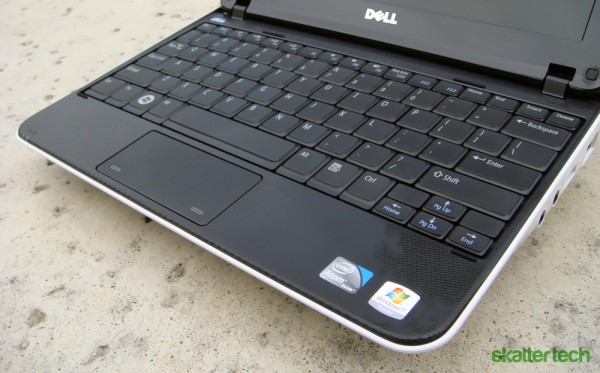
Since the Mini 9 first made its debut in late 2008, Dell has been continuously pumping new models into the assembly line in hopes of securing a portion of the global netbook market share. While the Mini 9 was heavily criticized for its cramped keyboard and slow performance, the latest Mini 10 model fixes that and comes with many improvements. A larger chassis sporting the latest Intel Pine Trail, a powerful 6-cell battery, and a large hard drive makes for a better overall experience. With an attractive price-point, the netbook seems appealing; however there are a few items worth mentioning for prospective buyers.
Dell Mini 10 Specifications:
- Processor: 1.66-GHz Intel Atom N450
- OS: Microsoft Windows 7 Starter Edition
- RAM: 1GB DDR2 SDRAM at 667MHz
- HDD: 250GB at 5400 RPM
- Screen: 10.1-inch Glossy 1024×600
- Graphics: Intel GMA 3150
- Wireless: WiFi 802.11b/g | Bluetooth v2.1
- Battery: 6-cell Lithium-Ion
- Card Reader: 3-in-one supported
- Size: 10.5 (W) x 7.7 (L) x 1.3 (D) inches
- Approximate Weight: 3.0 pounds
Design & Hardware
The new Dell Mini 10 is a completely new take on preceding models. It features an unusual clam-shell design with a display lid that doesn’t entirely cover the base. While Dell offers the Mini 10 in various colors including black, blue, green, pink, purple and red, the internal keyboard area and undercarriage remain black and white, respectively. Only the back of the display gets the paint job. Weighing in at about 3 pounds with a six cell battery, the Inspiron Mini 10 is beginning to lose its “netbook” title. It is about 1.5 inches wider and one inch longer than the older Dell Mini 9, which is a significantly larger footprint. With that being said, Dell deserves credit for building a visually appealing product that’s also durable and robust. The entire frame has minimal flex with help from the nearly uni-body design. And despite a glossy finish, the plastic body hides fingerprints easily, keeping the netbook looking brand new.
Opening the Dell Mini 10 lid reveals the 10.1 inch display, a webcam, a keyboard and touchpad. The palm rest and surroundings, which extend to the “butt” of the device, feature a quilted pattern design. There are two LED indicators on the left lip for power status and HDD activity. The left side of the netbook features a VGA port, two USB ports, and a multi-card reader with a pre-installed dust saver. Moving over to the right side, the netbook has a headphone jack, microphone in, another USB port, and an Ethernet port. Finally the power port is off to the right on the back side. For the most part, it’s a fairly common configuration for netbooks. There are no special features such as a HDMI port or a TV tuner on this particular model.
On another note, I do have to mention that Dell did somewhat “cheat” on the Mini 10’s design. One of the largest complains from customers and reviewers is the bulge that comes with an extended battery pack. It generally ruins the aesthetics and shape of a netbook or laptop. However, with the Dell Mini 10, there is no change in size between a 3-cell or a 6-cell configuration. That’s because the “butt” sticks out irrespective whether or not an extended battery is inside. While the device maintains a clean-slated design with an extended battery, it does pack unnecessary volume for customers who opt for the cheaper 3-cell battery.
Keyboard & Touchpad
Netbooks have become known for condensed and cramped keyboards. Apple’s CEO, Steve Jobs, claims this is a reason why people are turning to tablets such as the iPad. After having a hard time getting accustomed my Dell Mini 9 when I first purchased it, I would have had to agree. However, Dell has entirely revamped the previous issues and churned out a fully functional keyboard on this model. Unlike the Mini 9, which lacked a functions key row, the Mini 10 has all the bare essentials. Keys are evenly spaced and aren’t awkwardly sized. For the first time with netbook, I was able to immediately type comfortably and quickly. There wasn’t a learning curve to get accustomed to a new arrangement, and typing felt natural. Each key-press offers enough tactile feedback to reaffirm a click. Secondary function keys even offer quick access to wireless settings, battery status, display brightness, and volume controls. The entire typing experience is the best I’ve had with a netbook keyboard. I can easily write an essay, chat, or even blog from my netbook, practically.
While the keyboard was wonderful, the situation with the touchpad is rather tragic. Dell tried to increase the surface area by embedding the left and right-click keys into the trackpad, which turns out to be a serous mistake. The actual “click-able” area for those keys is now limited to only the bottom corners. A traditional physical key arrangement would have been more practical. A larger touchpad general makes for a great environment for multi-touch gestures, but Dell unfortunately didn’t include the necessary software on this model. But the most prominent issue remains the left/right click buttons. Since these are above the touch sensitive trackpad, performing a physical clicking often results with the cursor jumping away. I found myself to using the old-fashion double-tap-to-click feature and making best with using the physical right-click key when needed. While Dell had the right idea for expanding the usable trackpad area, dropping physical keys won’t play well with all users.
The Display
While the Inspiron Mini 10 unit Dell sent Skatter Tech featured a 1024-by-600 pixel 10.1 inch LCD display, a higher resolution configuration option for 1366-by-768 pixels is also available. Our unit’s screen was bright and crisp with great horizontal viewing angles. There was minimal discoloration and washout even when seen from nearly a 180 degree angle. This makes the Mini 10 great for sharing videos with friends sitting beside you. On the other hand, vertical viewing angles weren’t nearly as great and the picture began to appear distorted past just 20 degrees. For the most part, reading text, viewing images, and watching videos wasn’t a problem in doors. Visibility becomes a larger issue under direct sunlight due to a glossy screen, but that’s a problem with just about every laptop.
Speakers and Headphones
Most netbooks I’ve owned or reviewed have generally had poor audio quality. The speakers were often cramped into awkward places such as under a keyboard, on the bottom or elsewhere to compensate for a lack of space. The Dell Mini 10, on the other hand, rocks out with an excellent set of stereo speakers, which are found under the lip on the front of the unit. Audio gets loud enough to watch videos when cooking, traveling in the back seat of a car, or just relaxing in bed. Keep in mind, audio sounds muffled if placed on a bed or sofa instead of a solid desk. The speakers somewhat lack on bass, which may be an issue for some genres of music, but they still produce highs articulately and crisply. Plugging in a pair of decent headphones only offers a superior listening experience.
Webcam and Microphone
The Mini 10’s webcam is by no means spectacular. It features a 1.3 megapixel webcam which is the standard for most netbooks. I put the webcam to the test with Skype 4.2, which supports HD-like video quality. As with most webcams, the Mini 10 struggled to perform well in low-light situations. Adjusting the brightness settings and adding additional light to my room solved the problem. Making out faces and expressions isn’t too difficult, but it’s not particularly great. An improved imaging sensor in a future iteration would be a welcome addition. That’s especially essential since video chat is becoming a larger part of our everyday lives. As for the microphone quality, it gets the job done for casual conversations. Programs such as Skype detect and select it automatically. People on the other end of the call could hear me clearly without any issues. If you want a better audio, you can always plug in a USB microphone or an analog one into the line-in port.
Performance
The Mini 10 sports the latest Pine Trail 1.66 GHz Intel Atom N450 CPU along with 1GB of RAM. It has an edge over the last generation of netbooks running on the Intel Atom N270 processor. Although improvements aren’t easily noticable when it comes to launch programs like Firefox, Skype, or Trillian, benchmarks do show better numbers. The wPrime 32 test took 126 seconds on the Mini 10 while it took 132 seconds on the Mini 9. With 1GB of RAM and a 250GB 5400RPM RPM HDD, the netbook booted into Windows 7 Starter Edition in about a minute and 30 seconds. It unfortunately took about a half-minute longer to reach the desktop than the Mini 9 with a Solid State Drive. On the other hand, the Mini 10 excelled when it came to read and write speeds. Regular file transfer operations copied a 1GB video podcast file at a rate of 22 MB/s. When it came to watching a live TV stream from SlingBox or an episode on Hulu, performance actually kept stable for the most part. There were a few occasional stutters, but it was an overall better experience than with other netbooks. A $30 Crystal HD Broadcom Media Accelerator upgrade, which wasn’t included in our review unit, is now available and should offer a vastly improved multimedia experience.
Battery Life
If there’s one predominately important feature for netbooks, it’s the battery life. The Dell Mini 10 easily exceeds expectations. I was able to squeeze about 9 hours on average out of the 6-cell battery pack. My usage generally consisted of typing on Microsoft Word and browsing the web. I also often had Skype running for instant messaging. Battery life does see a significant impact when watching Adobe Flash videos, heavily multitasking, or running resource intensive programs. For my kind of usage, though, the netbook lasts me through an entire day. I had the unit on me during my trip to Google I/O 2010 and WordCamp 2010. Although I carried the power adapter with me, I realized that I wouldn’t have to scavenge for a power outlet if started the day with a full charge. In comparison, the Mini 10 offers an edge of about 4 hours of additional runtime over the brand new Lenovo IdeaPad S10-3t and the now-outdated Dell Mini 9.
Included Software
I’m getting sick of bloatware and customers are too. Dell tries their best to cut costs for consumers by slapping unnecessary applications onto laptops, but it’s a serious mistake. While Skatter Tech readers, who are generally somewhat geeky, will simply start fresh with a clean install, the average buyer won’t know how. The included bloatware on the machine severely degrades battery life and makes for an unusable computing experience. My machine came pre-installed with a ridiculous number of programs including a Dell Dock, Cozi Calendar, GoToAssist, McAfee SecurityCenter, Microsoft Office Trial, Microsoft Works, Live Essentials, and a few more. Some of these, such as the extra dock program, are just simply unnecessary with the Windows 7 taskbar. And programs such as McAfee, brought the netbooks CPU to a grinding halt. My first experience with the Mini 10 left a bad taste in mouth since it would take a painstakingly longtime just to open a file browser or even Internet Explorer. Although I solved the problem by removing some programs, Dell needs to clean up their custom OS distribution. A jump up from Windows 7 Starter Edition would be nice too.
The Bottom Line
I’ve owned an Acer Aspire One, an Asus Eee PC, and a Dell Mini 9 since netbooks first made their debut. I’ve also tested a Lenovo, Sony, and a few other brand-name netbooks, but the Dell Inspiron Mini 10 became my instant favorite. Aside from a few complains about it being a bit bulkier than the average netbook and having a less than phenomenal touchpad, it’s one of the best netbooks I’ve come across. Issues such as bloatware aren’t limited only to Dell, most laptops come with the same issue. When it comes down to it, the Dell’s netbook offers an amazing 9-hour battery life and even has a visually appeal form factor. With an excellent display for multimedia, a quality set of stereo speakers for tunes, and a great keyboard for typing away, the Mini 10 has all the bare essentials. The netbook doesn’t falter on performance either. The starting price of just $299 for the base model is attractive too. If you are looking for netbook with great battery life at an affordable price, you can’t go wrong with the Dell Inspiron Mini 10.
Buy: $309 for Mini 10 on Amazon
Links: Dell.com Inspiron Mini 10













“Dell tried to increase the surface area by embedding the left and right-click keys into the trackpad, which turns out to be a serous mistake. The actual “click-able” area for those keys is now limited to only the bottom corners. A traditional physical key arrangement would have been more practical. A larger touchpad general makes for a great environment for multi-touch gestures, but Dell unfortunately didn’t include the necessary software on this model. But the most prominent issue remains the left/right click buttons. Since these are above the touch sensitive trackpad, performing a physical clicking often results with the cursor jumping away”
I think that they should have given an option that customers who want buttons, get buttons on the left and right side of the trackpad, where as customers who just want the trackpad(w/o buttons) get the one w/o buttons
Unfortunately, that can get very expensive to manufacture which is why companies stay way from offering so many varied models. Apple has such high profit margins mainly because they stick to a very simple product line. Sure they overcharge, but they also make a killing on each unit sold.